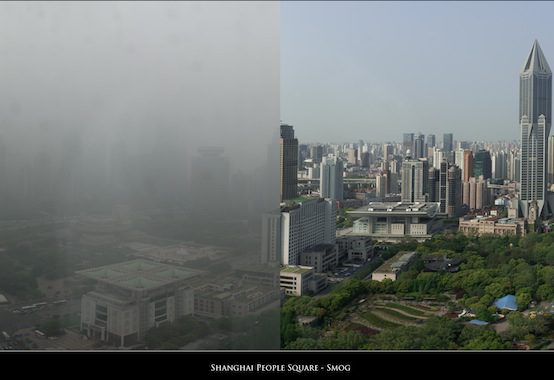Smog Threatens the Chinese Security State

You can’t watch people you can’t see. That’s the lesson Chinese authorities are learning as they come to terms with an unforeseen threat to their national surveillance apparatus: smog.
As Ariel Bogle of Slate writes,
China has long been very enthusiastic about security cameras. Since 2005, the government has rolled out surveillance in public places, parks, and even on buses and in classrooms, as part of an operation called “Skynet”. … Some estimate that there are about 30 million cameras operating in China—that’s one for every 43 citizens.
Over that same period, the effects of rapid Chinese industrialization have resulted in ever-escalating air pollution, recently estimated to contribute to 1.2 million premature deaths in the country. Yesterday, AFP reported that “An eight-year-old girl has become China’s youngest lung cancer patient, reports said, with doctors blaming pollution as the direct cause of her illness.” With smog levels recently shutting down the northeastern city of Harbin, Chinese officials have been increasingly nervous about the reaction to the air pollution. So official state media has often called the pollution “fog,” according to Quartz’s Gwynn Guilford, a judgment the Chinese people had little ability to challenge.
The problem is, the South China Morning Press reports, smog is particularly threatening to the local panopticon. Cameras have traditionally had problems with regular fog from time to time as would be expected, but research has indicated possible countermeasures to beef back up the surveiling, including using infrared cameras to cut through the concentrated water vapor. Smog, on the other hand, is the result of dispersed particles, not water, and the particles are proving to have very different optical qualities. After a bombing in Tienanmen Square, Chinese officials are reportedly concerned that terrorists could use high air pollution days to conceal further attacks.
As a result, China is putting tremendous pressure on both civilian and military teams to find some way to maintain its monitoring system during the country’s famously smoggy days. One expert the SCMP talked to suggested using a radar system that wouldn’t be impeded by elevated levels of particulate matter in the air, with the only downside being exposing the population to radiation levels on top of the smog.
The Chinese predicament holds a century’s worth of progression in the dystopic tradition all within itself, as a state-run panopticon, the stuff of early 20th century totalitarian dystopias, (presumably unwittingly) titled after a post-apocalyptic nuclear dystopia out of the 1980s, is thwarted by the environmental degradation that has succeeded nukes as the 21st century apocalypse of choice. In fact, it is a reminder that the totalitarian logic that animated those earliest dystopias is still alive and well in certain parts of the world, as a government becomes truly alarmed at the growing uninhabitability of its cities only when those conditions interfere with its instruments of control.
Comments